Book contents
- Frontmatter
- Contents
- List of Contributors
- Preface
- 1 Globalisation and the sustainability of agricultural landscapes
- 2 Agricultural liberalisation, multifunctionality and the WTO: competing agendas for the future of farmed landscapes
- 3 Globalisation of agricultural landscapes: a land systems approach
- 4 Agricultural landscape changes through globalisation and biodiversity effects
- 5 Swiss agricultural policy reform: landscape changes in consequence of national agricultural policy and international competition pressure
- 6 Local landscape consequences of macro-scale policy reform: the New Zealand experiment
- 7 Rural landscape differentiation in the face of changing demands and policies: a typology of rural areas in Portugal
- 8 Globalisation and the local agricultural landscape: current change patterns and public policy interventions
- 9 From totalitarian to democratic landscapes: the transition in Estonia
- 10 Rural landscape change as a product of US federal policy
- 11 New approaches for urban–rural areas in Dutch spatial planning
- 12 Restoring agricultural landscapes in shrinking cities: re-inventing traditional concepts in Japanese planning
- 13 Globalisation and local agricultural landscapes: patterns of change, policy dilemmas and research questions
- Index
- References
2 - Agricultural liberalisation, multifunctionality and the WTO: competing agendas for the future of farmed landscapes
Published online by Cambridge University Press: 05 June 2012
- Frontmatter
- Contents
- List of Contributors
- Preface
- 1 Globalisation and the sustainability of agricultural landscapes
- 2 Agricultural liberalisation, multifunctionality and the WTO: competing agendas for the future of farmed landscapes
- 3 Globalisation of agricultural landscapes: a land systems approach
- 4 Agricultural landscape changes through globalisation and biodiversity effects
- 5 Swiss agricultural policy reform: landscape changes in consequence of national agricultural policy and international competition pressure
- 6 Local landscape consequences of macro-scale policy reform: the New Zealand experiment
- 7 Rural landscape differentiation in the face of changing demands and policies: a typology of rural areas in Portugal
- 8 Globalisation and the local agricultural landscape: current change patterns and public policy interventions
- 9 From totalitarian to democratic landscapes: the transition in Estonia
- 10 Rural landscape change as a product of US federal policy
- 11 New approaches for urban–rural areas in Dutch spatial planning
- 12 Restoring agricultural landscapes in shrinking cities: re-inventing traditional concepts in Japanese planning
- 13 Globalisation and local agricultural landscapes: patterns of change, policy dilemmas and research questions
- Index
- References
Summary
Introduction
The international policy context is becoming increasingly important in any discussion of farmland sustainability and landscape change. In particular, the infrastructure of trade rules, subsidy codes and dispute settlement procedures overseen by the World Trade Organization (WTO) means that the governance of agriculture is ever more an international concern. The Agreement on Agriculture which concluded the Uruguay Trade Round in 1993, for instance, set boundaries on what national governments can do in terms of offering subsidies to farmers, and we have seen changes in the level and pattern of farm support in industrialised countries that have been a direct response to the politics of international trade (Higgins and Lawrence, 2005; Peine and McMichael, 2005). The latest round of trade talks under the Doha round, launched in 2001, continues this process of internationalisation, requiring negotiators to make progress towards furthering the market opening and decoupling of support that has come to define the liberalisation process. Negotiations were formally suspended in July 2006 but discussions are now underway to conclude the talks. At the time of writing (January 2009) a revised outline agriculture agreement is under active discussion. Pressure to complete the round remains strong and the consensus is that the resulting further liberalisation of markets and policy will be a major driver of land use and landscape change over the medium term, particularly in places like the European Union (EU) where protectionist policies are so long established and deeply entrenched.
- Type
- Chapter
- Information
- Globalisation and Agricultural LandscapesChange Patterns and Policy trends in Developed Countries, pp. 17 - 30Publisher: Cambridge University PressPrint publication year: 2010
References
- 1
- Cited by



